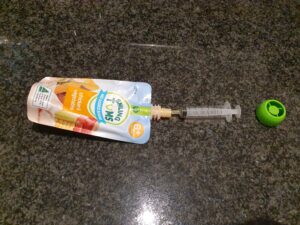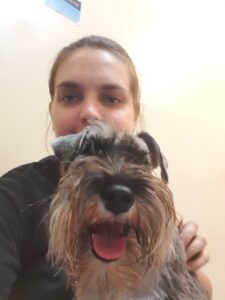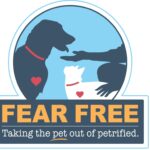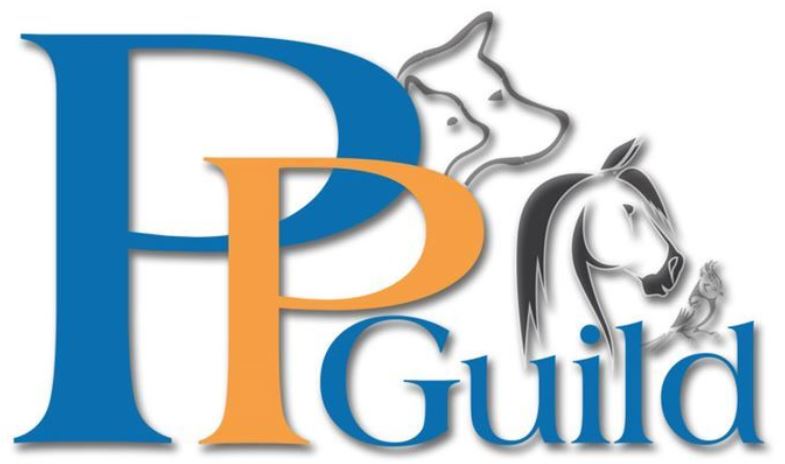Force Free, Fear Free – What does it mean?
Force Free Fear Free Veterinary Care for Dogs. What does it mean? A hands off approach that takes the scare out of pet care. It aims to relieve fear, anxiety and stress, to make vet visits easier and safer. Here is a real world example.
I had to take a relative’s dog to the vet. Here’s a few things that would contribute to veterinary care being more challenging than usual:
- Milly should normally be taking extra medication before going to the vet to help her cope. However, this was an unscheduled urgent visit, so she did not have that buffer.
- Also, she is not my dog. I do not have a deep bond or long history with her.
- And she does not like having her face touched (she’s pretty sensitive to handling all over really)
She’s scared – what do you do?
Milly was physically shaking and did not want to be put on the examination table. She had already barked at the Vet staff who entered the room.
It could have been suggested that I restrain her, and the staff administer medication. Or they restrain her, and I administer medication. They could even suggest taking her away from me ‘out the back’ to ‘deal with it.’
The thing with force is that an already stressed, scared dog can be put over threshold and bite in response to that extra pressure applied. This is not safe for the staff or caregivers.
Secondly, you may get away with force once – but then what? What if you need to continue treatment and the dog has ‘wised up’ to what you’re about? And they avoid you, or become more fearful or aggressive? It makes future treatment even harder.
A force free fear free approach
The veterinary staff are really nice and give Milly distance and treats. They also made a great decision to leave Milly alone with me in the room and for me alone to administer the medication.
I use a ‘quick and dirty’ desensitisation method.
I say ‘quick’ because it’s still urgent. I’m not going to spend as much time on this as I would like. I just need to get it done. It’s no conditioned emotional response or flawlessly trained operant behaviour.
I say ‘dirty’ because it’s not some kind of perfect set up. I do not have perfectly chopped food in an accessible container or training bag. There’s no clicker. I haven’t given thought about the ‘training set up’ in the environment I’m in. I have a chunk of food in a plastic bag I hastily grabbed just in case I needed it.
However, in all of this I don’t need to physically restrain her body, touch her face or pry open her mouth. It’s force free.
Instead I reward her for touching the syringe a few times. Then I feed her while the syringe is at her mouth. And then actually squirt the solution in the syringe into her mouth.
I’m sure the squirt was a nasty surprise and I’m sure it tasted gross. But it’s way less traumatic an experience than it could have been had we physically restrained and forced her. I’m glad we took the other option. I’ll always advocate for the least intrusive, minimally aversive treatment or training plan.
Force Free Fear Free Veterinary Care for dogs is not just a theoretical ideology – it is an achievable practical outcome.
At home training and care

Just to be sure we don’t develop a mistrust of syringes in case they’re needed in the future I also feed her yummy stuff out of a syringe at home too.
An ounce of prevention is worth a pound of cure. In my puppy preschool classes for puppies who are 8 to 14 weeks old and Kindy puppy training class for puppies who are 15 to 24 weeks old I address husbandry for grooming and vet visits. We practice how to get puppies used to veterinary examinations. I also give practical advice about how to get your dog to love it, not just tolerate it. These techniques can be used to prevent fear in dogs, and they also work if the dog is already fearful.
The end result
Your pets vet visit does not always need to be a traumatic experience. They don’t always need to be manhandled or ‘taken out the back’
There are other ways to treat animals. And you can do training with your pets to help them.

Camden Valley Animal Hospital have Fear Free certified staff. This is where I took Milly. Their waiting room has separated the area for dogs and cats with visual blocking from panels. They use Adaptil in their consult rooms and have covered the traditional slippery examinations tables with comfortable towels. All of these little changes makes for a more pleasant experience for you and your pet.
I have also visited Great Western Animal Hospital who have Fear Free certified staff as well.
Where can you get help if you need it?
You can find a veterinary practice that has Fear Free certified staff that can better work with you and your fearful or reactive dog so as to not make matters worse.
You can also work with a qualified force free dog trainer to practice grooming or veterinary behaviours at home, and these professional trainers can give you coaching and guidance to implement it with your vet or groomer.
Fear Free is an education service and their mission is to prevent and alleviate fear, anxiety and stress in pets. If you think your dog could benefit from taking the scare out of pet care, and want to find a Fear Free vet, use the map to help you locate a veterinary practice in Australia that has Fear Free certified professionals it just takes a while to load so be patient.
You can also find a force free dog trainer nearest to you in Australia by using the Pet Professional Guild Australia’s map
Want to learn more? The Pet Professional Guild Australia have webinars on this kind of care. Co-operative Care Training for Vet Visits & Collaborative Care – For All Animals in Human Care
Do you live in Greater Western Sydney? If you have a dog who baulks at going to the vet I can help you too contact me today


